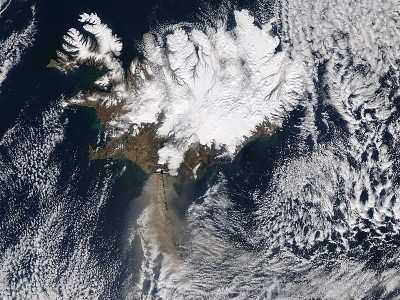Sat, Apr 24, 2010
SAIB Published With Guidelines, But Does Not Recommend Flight
Into Visible Ash
 The FAA this week published an SAIB (Special Airworthiness
Information Bulletin) addressing concerns about the operation of
aircraft with turbine engines into areas where volcanic ash is
present. The SAIB is specifically directed toward operators that
operate in Europe or operate in and out of Europe, while the
Icelandic volcano, Mount Eyjafjallajokull, is still active.
The FAA this week published an SAIB (Special Airworthiness
Information Bulletin) addressing concerns about the operation of
aircraft with turbine engines into areas where volcanic ash is
present. The SAIB is specifically directed toward operators that
operate in Europe or operate in and out of Europe, while the
Icelandic volcano, Mount Eyjafjallajokull, is still active.
After Mount Eyjafjallajokull ended almost 200 years of dormancy
with an eruption on March 20, EUROCONTROL shut down airspace
throughout various airports in Europe as a result of the drifting
volcanic ash cloud from the eruption On April 14. Since that
initial shutdown, the UK CAA has led a coordinated effort that
included the FAA. The effort identified an acceptable level of
dissipating ash concentration which has subsequently allowed
EUROCONTROL to allow flights to resume in most regions.
Volcanic ash can pose a significant threat to aviation safety.
During the 1980s, a number of flights into volcanic ash clouds
occurred that resulted in the simultaneous shutdown of all engines.
Volcanic ash can present short-term as well as long-term
operational hazards to turbine engines. While the shortterm affects
of erosion and power loss are well documented, the long-term
effects of repeated exposures are not well understood.
The SAIB provides information and recommends that operators
follow all new and existing Maintenance and Operational
Instructions from the respective aircraft and engine manufacturers
(Type Certificate Holders) including any recommended post-flight
checks on aircraft that might have flown through airspace
contaminated with volcanic ash. The European Aviation Safety Agency
(EASA) is issuing a Safety Information Bulletin on operations in
and around volcanic ash.

Before flying from the United States to Europe or within Europe,
aircraft owners and operators should review the following
recommendations:
- Although the FAA does not recommend engine operation or flight
into a visible volcanic ash cloud, we do recommend that you obtain
definitive information on operational limitations around ash
clouds, if any, from each of the European National Authority of the
State(s), of which you plan flight operations.
- Follow all aircraft and engine manufacturer’s operating
and maintenance instructions pertaining to operations in airspace
where volcanic ash may be near or present.
- Report any inadvertent encounter with volcanic ash or relevant
findings, including abnormal engine behavior, to the respective
type certificate holders of the aircraft and engines.
More News
Also: ANOTHER Illegal Drone, KidVenture Educational Activities, Record Launches, TSA v Shoes The Senate confirmed Bryan Bedford to become the next Administrator of the FAA, in a ne>[...]
Also: Sully v Bedford, Embraer Scholarships, NORAD Intercepts 11, GAMA Thankful Middle Georgia State University will be joining the Federal Aviation Administration’s fight ag>[...]
Also: DarkAero Update, Electric Aircraft Symposium, Updated Instructor Guide, OSH Homebuilts Celebrate The long-awaited Sonex High Wing prototype has flown... the Sonex gang tells >[...]
Also: Sully v Bedford, Embraer Scholarships, NORAD Intercepts 11, GAMA Thankful Middle Georgia State University will be joining the Federal Aviation Administration’s fight ag>[...]
30-Year USCG Veteran Aviator Focusing On Member Benefits The Vertical Aviation International Board of Directors announced its new leadership officers in April, and all began their >[...]
 Airborne 07.11.25: New FAA Boss, New NASA Boss (Kinda), WB57s Over TX
Airborne 07.11.25: New FAA Boss, New NASA Boss (Kinda), WB57s Over TX Airborne-Flight Training 07.10.25: ATC School, Air Race Classic, Samson School
Airborne-Flight Training 07.10.25: ATC School, Air Race Classic, Samson School Airborne Affordable Flyers 07.03.25: Sonex HW, BlackShape Gabriel, PRA Fly-In 25
Airborne Affordable Flyers 07.03.25: Sonex HW, BlackShape Gabriel, PRA Fly-In 25 Airborne-Flight Training 07.10.25: ATC School, Air Race Classic, Samson School
Airborne-Flight Training 07.10.25: ATC School, Air Race Classic, Samson School Rick Kenin New Board Chair of VAI
Rick Kenin New Board Chair of VAI




